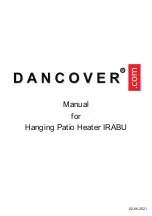
49
11 - MAINTENANCE
11.2 GENERAL
Maintenance must be done by authorized centres or by
qualified personnel
The maintenance allows to:
•
maintain the unit efficiency
•
reduce the deterioration speed to whom every equipment
is subject over time
•
assemble information and data to understand the state of
the unit efficiency and avoid possible damages
Before checking, please verify the following:
•
the electrical power supply line should be isolated at the
beginning
•
the unit isolator is open, locked and equipped with the
suitable warning
•
make sure no tension is present
After turning off the power, wait at least 5 minutes before
accessing to the electrical panel or any other electrical
component.
Before accessing check with a multimeter that there are no
residual stresses.
11.7 STRUCTURE
After a long term use, check the unit base and fittings.
If damaged, the unit may sink and result in injury.
Perform an inspection every 6 months minimum.
The frequency, however, depends on the use.
In the event of frequent use it is recommended to plan
inspections at close intervals:
•
frequent use (continuous or very intermittent use, near the
operating limits, etc)
•
critical use (service necessary).
11.3 INSPECTIONS FREQUENCY
11.4 UNIT BOOKLET
It’s advisable to create a unit booklet to take notes of the unit
interventions.
In this way it will be easier to adequately note the various
interventions and aid any troubleshooting.
Report on the booklet:
•
data
•
type of intervention effected
•
intervention description
•
carried out measures etc.
In some cold areas (under 0°C), if the system will be stopped
for a long time, empty the storage storage tank in order to
avoid the water freezing and damage of E-heater.
If a long period of inactivity is foreseen:
•
put the unit in OFF
•
wait a few minutes to allow all the actuators to reach the
rest position
•
Turn off the power in order to avoid electrical risks or
damages by lightning strikes
•
Evacuate all the water storage storage tank and the
pipeline and close all the valves;
It’s recommended that the starting-up after the stopping
period is performed by a qualified technician, especially after
seasonal stops or seasonal switch.
When restarting, refer to what is indicated in the START-UP
section.
Schedule technical assistance in advance to avoid hitches
and to guarantee that the system can be used when required.
11.5 PUT AT REST
Check the condition of the structure parts .
Paint so as to eliminate or reduce oxidation where needed.
Check that the paneling is correctly fastened. Poor fastening
may give rise to malfunctions and abnormal noise and vibra-
tion .
11.8 SAFETY VALVE
The safety valves must be checked regularly.
Almost all losses are caused by impurities deposited inside
the valve.
It’s normal if some water drops from the hole of saftey valve
during operation.
But, if there is a great amount of water, call your service
agent for instructions.
Please beware of burn, beware of the hot water from the
valve.
To clean the valve:
1. Manually open the valve
2. Turn the knob as indicated by the arrow on the knob itself
11.6 COIL
Accidental contact with the exchanger flaps can cause injuries
from cut: use protective gloves.
The coil must allow maximum thermal exchange, therefore,
the surface must be clear from dirt and scaling.
Clean the air inlet side.
Use a soft brush or aspirator.
Check the aluminium flaps have not been damaged or folded,
otherwise will be from "comb" the coil for excellent air flow.
( contact an authorised after-sales assistance centre )
















































